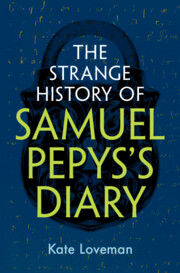Refine search
Actions for selected content:
31 results
Chapter 4 - (Post)colonial Books as Commodity and Anti-Commodity
- from Part I - Origins
-
-
- Book:
- Commodities and Literature
- Published online:
- 14 October 2025
- Print publication:
- 09 October 2025, pp 76-96
-
- Chapter
- Export citation
Chapter 2 - Michael Field’s Diary
- from Part I - Works and Days
-
-
- Book:
- Michael Field in Context
- Published online:
- 03 October 2025
- Print publication:
- 25 September 2025, pp 12-19
-
- Chapter
- Export citation
Chapter 30 - Ecology
- from Part V - Afterlives and Future Fields
-
-
- Book:
- Michael Field in Context
- Published online:
- 03 October 2025
- Print publication:
- 25 September 2025, pp 288-296
-
- Chapter
- Export citation
Chapter 4 - Collaborative Authorship
- from Part I - Works and Days
-
-
- Book:
- Michael Field in Context
- Published online:
- 03 October 2025
- Print publication:
- 25 September 2025, pp 30-38
-
- Chapter
- Export citation
Chapter 2 - Logbooks
-
- Book:
- Maritime Relations
- Published online:
- 23 August 2025
- Print publication:
- 04 September 2025, pp 60-100
-
- Chapter
- Export citation
4 - Back from the Edge
-
- Book:
- Waves of Hope
- Published online:
- 26 May 2025
- Print publication:
- 12 June 2025, pp 63-90
-
- Chapter
- Export citation

The Strange History of Samuel Pepys's Diary
-
- Published online:
- 24 April 2025
- Print publication:
- 24 April 2025
Introduction
-
- Book:
- The Strange History of Samuel Pepys's Diary
- Published online:
- 24 April 2025
- Print publication:
- 24 April 2025, pp 1-14
-
- Chapter
- Export citation
Chapter 8 - Reading against the Grain
-
- Book:
- The Strange History of Samuel Pepys's Diary
- Published online:
- 24 April 2025
- Print publication:
- 24 April 2025, pp 151-176
-
- Chapter
- Export citation
Chapter 2 - Shorthand and Secrecy
-
- Book:
- The Strange History of Samuel Pepys's Diary
- Published online:
- 24 April 2025
- Print publication:
- 24 April 2025, pp 32-47
-
- Chapter
- Export citation
Chapter 5 - Victorian Pepys
-
- Book:
- The Strange History of Samuel Pepys's Diary
- Published online:
- 24 April 2025
- Print publication:
- 24 April 2025, pp 84-107
-
- Chapter
- Export citation
Chapter 4 - First Publication
-
- Book:
- The Strange History of Samuel Pepys's Diary
- Published online:
- 24 April 2025
- Print publication:
- 24 April 2025, pp 64-83
-
- Chapter
- Export citation
Chapter 6 - War and the Diary
-
- Book:
- The Strange History of Samuel Pepys's Diary
- Published online:
- 24 April 2025
- Print publication:
- 24 April 2025, pp 108-130
-
- Chapter
- Export citation
Chapter 3 - Saving the Diary
-
- Book:
- The Strange History of Samuel Pepys's Diary
- Published online:
- 24 April 2025
- Print publication:
- 24 April 2025, pp 48-63
-
- Chapter
- Export citation
Afterword
-
- Book:
- The Strange History of Samuel Pepys's Diary
- Published online:
- 24 April 2025
- Print publication:
- 24 April 2025, pp 177-183
-
- Chapter
- Export citation
Chapter 7 - ‘Every Last Obscenity’: Complete and Online
-
- Book:
- The Strange History of Samuel Pepys's Diary
- Published online:
- 24 April 2025
- Print publication:
- 24 April 2025, pp 131-150
-
- Chapter
- Export citation
An Introduction to Fukushima Diary: Diary of Shūhei Tomisawa, 20th-Generation Sake Brewer from Futaba, Japan
-
- Journal:
- Asia-Pacific Journal / Volume 21 / Issue 4 / April 2023
- Published online by Cambridge University Press:
- 14 March 2025, e4
-
- Article
-
- You have access
- Open access
- Export citation
28 days later: A prospective daily study on psychological well-being across the menstrual cycle and the effects of hormones and oral contraceptives
-
- Journal:
- Psychological Medicine / Volume 55 / 2025
- Published online by Cambridge University Press:
- 07 February 2025, e19
-
- Article
-
- You have access
- Open access
- HTML
- Export citation
9 - The People’s Army of Vietnam
- from Part I - Battlefields
-
-
- Book:
- The Cambridge History of the Vietnam War
- Published online:
- 02 January 2025
- Print publication:
- 28 November 2024, pp 189-217
-
- Chapter
- Export citation
Introduction
-
-
- Book:
- Decoding Anne Lister
- Published online:
- 29 June 2023
- Print publication:
- 13 July 2023, pp 1-17
-
- Chapter
-
- You have access
- Open access
- HTML
- Export citation
